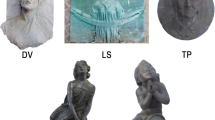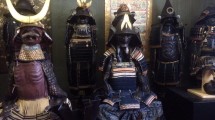Abstract
There is a long tradition in evaluating industrial atmospheres by measuring the corrosion rate of exposed metal coupons. The heritage community also uses this method, but the interpretation of the corrosion rate often lacks clarity due to the low corrosivity in indoor museum environments. This investigation explores the possibilities and drawbacks of different silver corrosion rate assessments. The corrosion rate is determined by three approaches: (1) chemical characterization of metal coupons using analytical techniques such as electrochemical measurements, SEM-EDX, XRD, and µ-Raman spectroscopy, (2) continuous corrosion monitoring methods based on electrical resistivity loss of a corroding nm-sized metal wire and weight gain of a corroding silver coated quartz crystal, and (3) characterization of the visual degradation of the metal coupons. This study confirms that subtle differences in corrosivity between locations inside a museum can be determined on condition that the same corrosion rate assessment is used. However, the impact of the coupon orientation with respect to the prevailing direction of air circulation can be substantially larger than the impact of the coupon location.




Similar content being viewed by others
Notes
The AER measurements were carried out in oaken display cases by measuring the decreasing CO2 level in the display case after filling it with gas, following the procedure described in [38].
References
ASHRAE, Museums, Galleries, Archives, and Libraries ASHRAE Handbook (I-P Edition) (ASHRAE Inc., Atlanta, 2011)
BIZOT green protocol (BIZOT Group, New York, 2014)
D. Camuffo, in Basic Environmental Mechanisms Affecting Cultural Heritage. Understanding Deterioration Mechanisms for Conservation Purposes, ed. by D. Camuffo, V. Fassina, J. Havermans (COST Action D 42: ENVIART, Nardini Editore, Firenze, 2010) p. 7
H.A. Ankersmit, H.T. Norman, S.F. Watts, Atmos. Environ. 39, 695 (2005)
V. Costa, Rev. Conserv. 2, 19 (2001)
ASHRAE Guideline 27P, in Measurement procedures for gaseous contaminants in commercial buildings, first public review draft (ASHRAE Inc. 2015), p. 12
V. Costa, M. Dubus, in Museum Microclimates, ed. by T. Padfield, K. Borchersen (National Museum of Denmark, Denmark, 2007), pp. 63–65
ASTM G1-90, in Annual Book of ASTM Standards 2001. vol. 03.02 (ASTM International, West Conshohocken, 2001b) p. 15–22
ASTM G4-95, in Annual Book of ASTM Standards 2001 (ASTM International, West Conshohocken, 2001) p. 45–53
E. Sacchi, C. Muller, ASHRAE J. 47(8), 40 (2005)
J. Tidblad, in Corrosion and Conservation of Cultural Heritage Metallic Artefacts, ed. by P. Dillman, G. Béranger, P. Piccardo, H. Matthiesen (CRC Press, New York, 2007), p. 37
ISO 11844-1, 5637-47 (International Standard Organization, Genève, 2006)
S. Capelo, P.M. Homem, J. Cavalheiro, I.T.E. Fonseca, J. Solid State Electrochem. 17, 223 (2013)
B. Ankersmit, The protection of silver from tarnishing: the use of silver tokens (SILPROT). (Indoor Air Pollution meeting, ICN, Amsterdam, the Netherlands, 26–27 August 1999). http://www.iaq.dk/iap/iap1999/1999_07.html. Accessed 1 June 2016
M. Dubus, Stud. Conserv. 55, 121 (2010)
M. Dubus, T. Prosek, e-Preserv Sci 9, 67 (2012)
T. Prosek, M. Kouril, M. Dubus, Stud. Conserv. 58(2), 118 (2013)
T. Prosek, Protection of Cultural Heritage by Real-Time Corrosion Monitoring. (MuseCorr, 2015). http://www.musecorr.eu/index.html. Accessed 1 May 2015
N. Sridhar, D.S. Dunn, C.S. Brossia, G.A. Cragnolino, J.R. Kearns, in Corrosion Tests and Standards, 2nd edn., ed. by By R. Baboian (ASTM International, West Conshohocken, 2005), p. 206, 225
ISO 11844-2. (International Standard Organization, Genève, 2006)
ASM G102-89, in Annual Book of ASTM Standards 2001. vol. 03.02 (ASTM International, West Conshohocken, 1994) p. 416–422
R. Bowman, Technical Note No: C.ER.GC.090705.1.0. (Rohrback Cosasco Systems, Doraville CA, US, 2014). http://www.cosasco.com/documents/Environmental_Corrosion_Monitoring_Purafil.pdf, Accessed 21 Nov 2014
ASTM B808-05 (ASTM International, West Conshohocken, 2005)
ASTM B826-97 (ASTM International, West Conshohocken, 1997)
V.M. Mecea, Sensor Actuator A Phys. 128, 270 (2006)
ISA 71.04-1985 (International Society for Automation, North Carolina, 1985)
C.M. Grzywacz, Monitoring for Gaseous Pollutants in Museum Environments (Getty Conservation Institute, Los Angeles, 2006), p. 63
NBN EN ISO 8891:2000 BSI (Bureau voor Normalisatie, Brussel, 2000)
BS EN ISO 2813 (International Standard Organization, Genève, 2014)
DIN 67530: 1982-01 (Deutsches Institut für Normung e. V., Germany, 1982)
CIE DS 014-4.3/E:2007 (CIE Central Bureau, Vienna, 2007)
H. Lin, G.S. Frankel, W.H. Abbott, J. Electrochem. Soc. 160(8), C345–C355 (2013)
I. Martina, R. Wiesinger, D. Jembrih-Simbürger, M. Schreiner, e-Preserv. Sci. 9, 1–8 (2012)
M. Striegel, The effects of low concentrations of gas phase formaldehyde on some inorganic materials found in museums. In AIC Objects Specialty Group, Post prints 1991, ed. By P. Hatchfield, vol. 1 (The American Institute for Conservation of Historic and Artistic Works, Washington D.C., 1992) p. 1–12
J. Tetréault, E. Cano, M. van Bommel, Stud. Conserv. 48, 1–6 (2003)
L.T. Gibson, C.M. Watt, Corros. Sci. 52, 172 (2010)
T. Padfield, Air Exchange Rate. Conservation Physics, 2014. http://www.conservationphysics.org/airex/air-exchange-moisture-buffer.pdf. Accessed 24 February 2016
A. Calver, H. Andy, D. Thickett, S. Weintraub, in Simple Methods to Measure Air Exchange Rates and Detect Leaks in Display and Storage Enclosures. ICOM Committee for Conservation, 14th Triennial Meeting (The Hague, The Netherlands, 2005) p. 597–609
Acknowledgments
This research has been sponsored by the Belgian Federal Public Planning Service Science Policy (BELSPO) under Project Number BR/132/A6/AIRCHECQ. In this project an innovative monitoring kit is developed that continuously and simultaneously measures both environmental parameters and material behaviour, enabling the study of the cause–effect relationships. The Quanta 250 FEG microscope at the University of Antwerp was funded by the Hercules foundation of the Flemish Government.
Author information
Authors and Affiliations
Corresponding author
Rights and permissions
About this article
Cite this article
‘t Hart, L., Storme, P., Anaf, W. et al. Monitoring the impact of the indoor air quality on silver cultural heritage objects using passive and continuous corrosion rate assessments. Appl. Phys. A 122, 923 (2016). https://doi.org/10.1007/s00339-016-0456-2
Received:
Accepted:
Published:
DOI: https://doi.org/10.1007/s00339-016-0456-2




